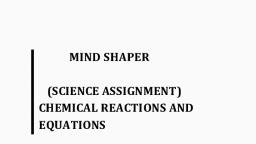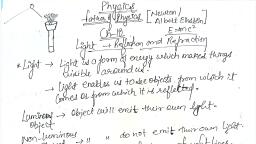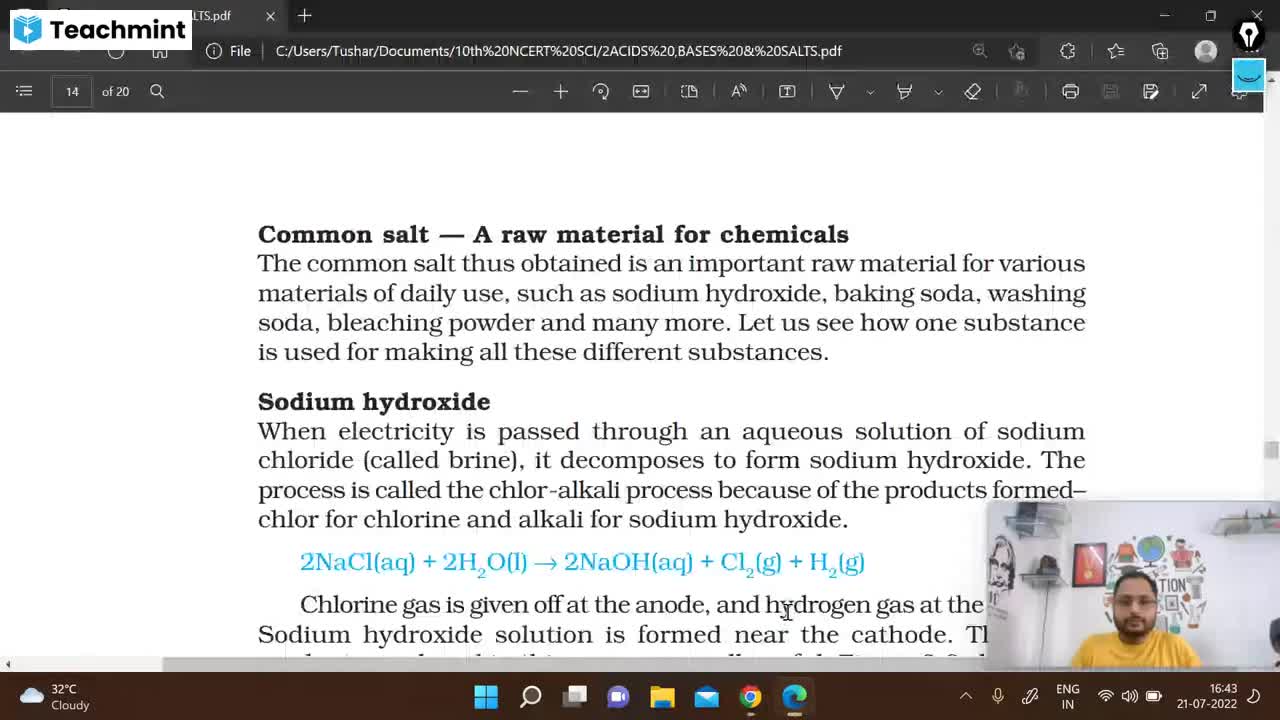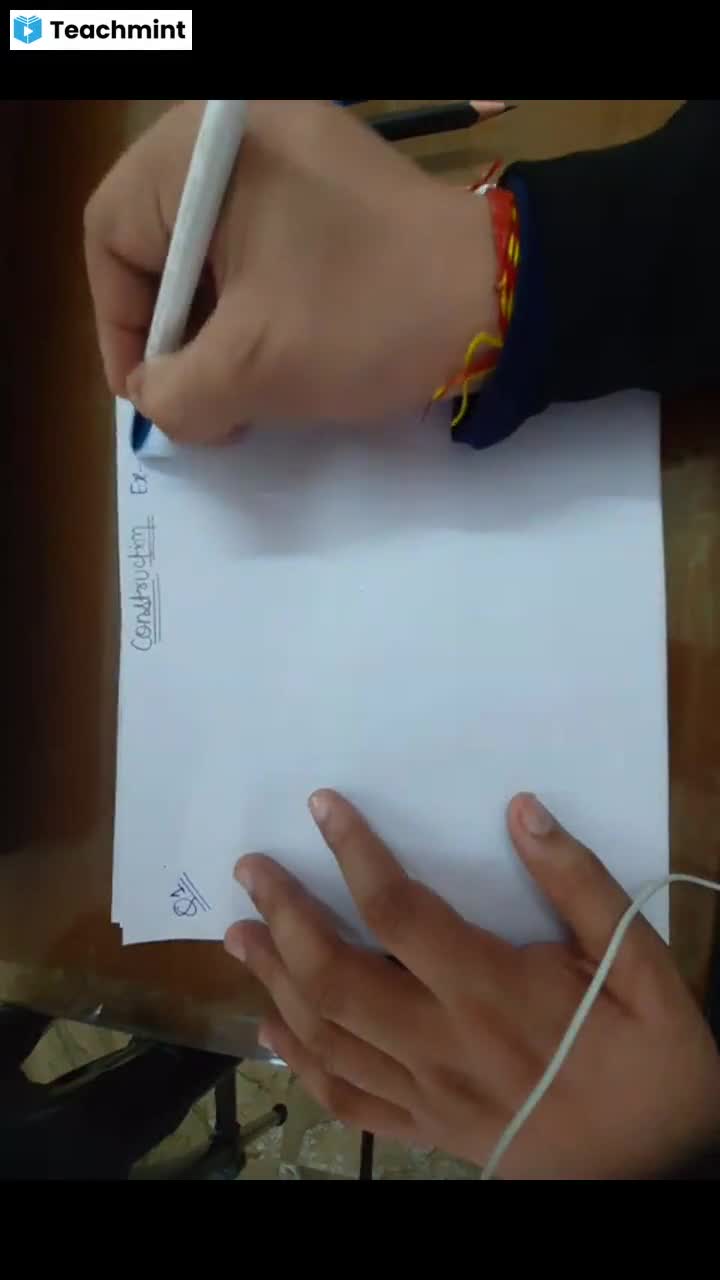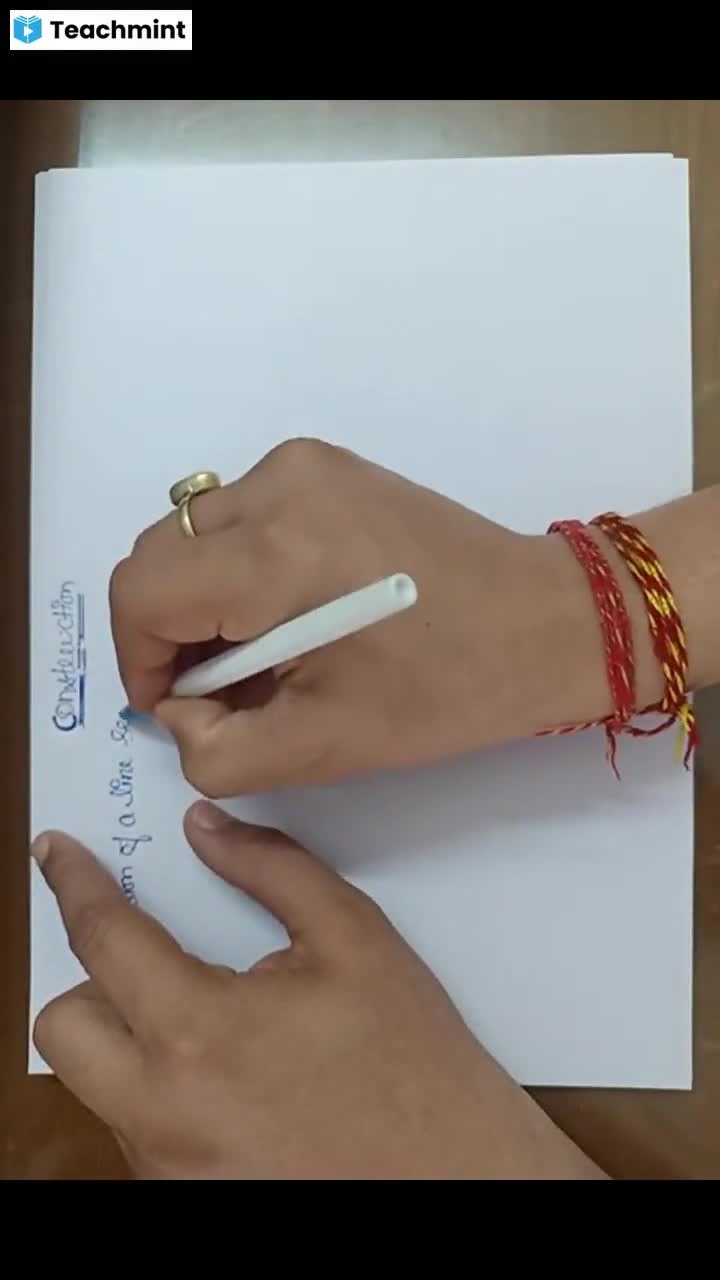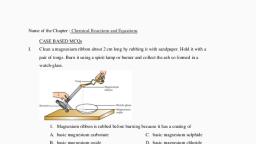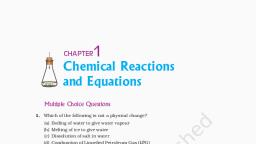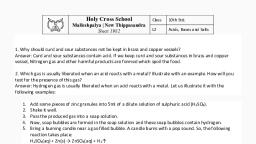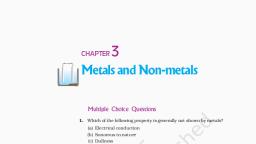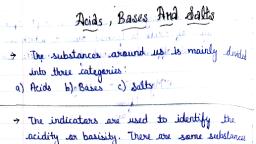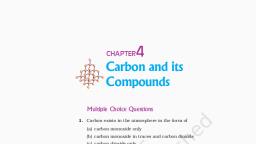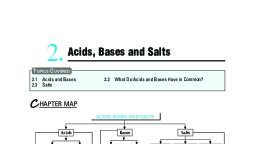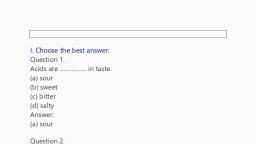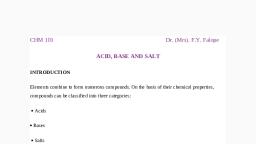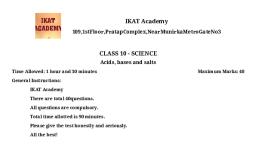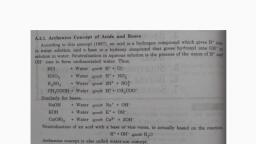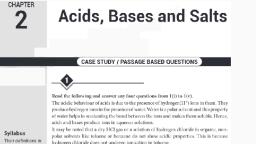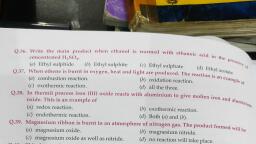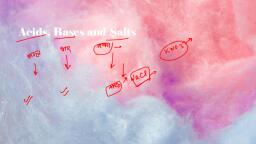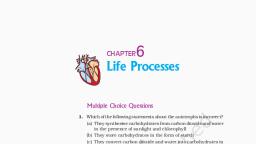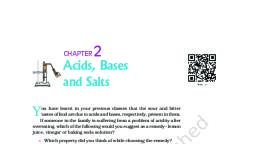Page 1 :
CHAPTER, , 2, , Acids, Bases, and Salts, Multiple Choice Questions, 1. What happens when a solution of an acid is mixed with a solution, of a base in a test tube?, (i), (ii), (iii), (iv), , The temperature of the solution increases, The temperature of the solution decreases, The temperature of the solution remains the same, Salt formation takes place, , (a) (i) only, (c) (ii) and (iii), , (b) (i) and (iii), (d) (i) and (iv), , 2. An aqueous solution turns red litmus solution blue. Excess, addition of which of the following solution would reverse the, change?, (a) Baking powder, (b) Lime, (c) Ammonium hydroxide solution, (d) Hydrochloric acid, 3. During the preparation of hydrogen chloride gas on a humid day,, the gas is usually passed through the guard tube containing calcium, chloride. The role of calcium chloride taken in the guard tube is to, (a), (b), (c), (d), , absorb the evolved gas, moisten the gas, absorb moisture from the gas, absorb Cl– ions from the evolved gas, , 4. Which of the following salts does not contain water of crystallisation?, (a) Blue vitriol, (b) Baking soda, (c) Washing soda, (d) Gypsum, , 07/05/2018
Page 2 :
5. Sodium carbonate is a basic salt because it is a salt of, (a), (b), (c), (d), , strong acid and strong base, weak acid and weak base, strong acid and weak base, weak acid and strong base, , 6. Calcium phosphate is present in tooth enamel. Its nature is, (a), (b), (c), (d), , basic, acidic, neutral, amphoteric, , 7. A sample of soil is mixed with water and allowed to settle. The, clear supernatant solution turns the pH paper yellowish-orange., Which of the following would change the colour of this pH paper, to greenish-blue?, (a), (b), (c), (d), , Lemon juice, Vinegar, Common salt, An antacid, , 8. Which of the following gives the correct increasing order of acidic, strength?, (a), (b), (c), (d), , Water <Acetic acid <Hydrochloric acid, Water <Hydrochloric acid <Acetic acid, Acetic acid <Water <Hydrochloric acid, Hydrochloric acid <Water <Acetic acid, , 9. If a few drops of a concentrated acid accidentally spills over the, hand of a student, what should be done?, (a) Wash the hand with saline solution, (b) Wash the hand immediately with plenty of water and apply a, paste of sodium hydrogencarbonate, (c) After washing with plenty of water apply solution of sodium, hydroxide on the hand, (d) Neutralise the acid with a strong alkali, 10. Sodium hydrogencarbonate when added to acetic acid evolves a gas., Which of the following statements are true about the gas evolved?, (i), (ii), (iii), (iv), , It turns lime water milky, It extinguishes a burning splinter, It dissolves in a solution of sodium hydroxide, It has a pungent odour, , (a) (i) and (ii), (c) (ii), (iii) and (iv), , 10, , (b) (i), (ii) and (iii), (d) (i) and (iv), , E XEMPLAR P ROBLEMS – SCIENCE, , 07/05/2018
Page 3 :
11. Common salt besides being used in kitchen can also be used as, the raw material for making, (i), (ii), (iii), (iv), , washing soda, bleaching powder, baking soda, slaked lime, , (a) (i) and (ii), (c) (i) and (iii), , (b) (i), (ii) and (iv), (d) (i), (iii) and (iv), , 12. One of the constituents of baking powder is sodium, hydrogencarbonate, the other constituent is, (a), (b), (c), (d), , hydrochloric acid, tartaric acid, acetic acid, sulphuric acid, , 13. To protect tooth decay we are advised to brush our teeth regularly., The nature of the tooth paste commonly used is, (a), (b), (c), (d), , acidic, neutral, basic, corrosive, , 14. Which of the following statements is correct about an aqueous, solution of an acid and of a base?, (i) Higher the pH, stronger the acid, (ii) Higher the pH, weaker the acid, (iii) Lower the pH, stronger the base, (iv) Lower the pH, weaker the base, (a) (i) and (iii), (c) (i) and (iv), , (b) (ii) and (iii), (d) (ii) and (iv), , 15. The pH of the gastric juices released during digestion is, (a), (b), (c), (d), , less than 7, more than 7, equal to 7, equal to 0, , 16. Which of the following phenomena occur, when a small amount of, acid is added to water?, (i), (ii), (iii), (iv), , Ionisation, Neutralisation, Dilution, Salt formation, , (a) (i) and (ii), (c) (ii) and (iii), ACIDS, BASES, , AND, , SALTS, , (b) (i) and (iii), (d) (ii) and (iv), 11, , 07/05/2018
Page 4 :
17. Which one of the following can be used as an acid–base indicator, by a visually impared student?, (a), (b), (c), (d), , Litmus, Turmeric, Vanilla essence, Petunia leaves, , 18. Which of the following substance will not give carbon dioxide on, treatment with dilute acid?, (a), (b), (c), (d), , Marble, Limestone, Baking soda, Lime, , 19. Which of the following is acidic in nature?, (a), (b), (c), (d), , Lime juice, Human blood, Lime water, Antacid, , Bulb, , 6 volt battery, , Switch, , 20. In an attempt to demonstrate electrical conductivity, through an electrolyte, the following apparatus, (Figure 2.1) was set up., , Beaker, , Nail, Dilute NaOH, solution, Rubber, cork, , Fig. 2.1, , Which among the following statement(s) is(are), correct?, (i) Bulb will not glow because electrolyte is not, acidic, (ii) Bulb will glow because NaOH is a strong base, and furnishes ions for conduction., (iii) Bulb will not glow because circuit is incomplete, (iv) Bulb will not glow because it depends upon, the type of electrolytic solution, , (a) (i) and (iii), (c) (ii) only, , (b) (ii) and (iv), (c) (iv) only, , 21. Which of the following is used for dissolution of gold?, (a), (b), (c), (d), , 12, , Hydrochloric acid, Sulphuric acid, Nitric acid, Aqua regia, , E XEMPLAR P ROBLEMS – SCIENCE, , 07/05/2018
Page 5 :
22. Which of the following is not a mineral acid?, (a), (b), (c), (d), , Hydrochloric acid, Citric acid, Sulphuric acid, Nitric acid, , 23. Which among the following is not a base?, (a), (b), (c), (d), , NaOH, KOH, NH4OH, C2H5 OH, , 24. Which of the following statements is not correct?, (a) All metal carbonates react with acid to give a salt, water and, carbon dioxide, (b) All metal oxides react with water to give salt and acid, (c) Some metals react with acids to give salt and hydrogen, (d) Some non metal oxides react with water to form an acid, 25. Match the chemical substances given in Column (A) with their, appropriate application given in Column (B), Column (A), , Column (B), , (A) Bleaching powder, , (i) Preparation of glass, , (B) Baking soda, , (ii) Production of H2 and Cl2, , (C) Washing soda, , (iii) Decolourisation, , (D) Sodium chloride, , (iv) Antacid, , (a) A—(ii),, , B—(i),, , C—(iv),, , D—(iii), , (b) A—(iii),, , B—(ii),, , C—(iv),, , D—(i), , (c) A—(iii),, , B—(iv),, , C—(i),, , D—(ii), , (d) A—(ii),, , B—(iv),, , C—(i),, , D—(iii), , 26. Equal volumes of hydrochloric acid and sodium hydroxide, solutions of same concentration are mixed and the pH of the, resulting solution is checked with a pH paper. What would be the, colour obtained? (You may use colour guide given in Figure 2.2, 0, , 1, , 2, , 3, , 4, , 5, , 6, , 7, , 8, , 9, , 10, , 11, , 12, , 13, , 14, , Figure 2.2, , ACIDS, BASES, , AND, , SALTS, , 13, , 07/05/2018
Page 6 :
(a), (b), (c), (d), , Red, Yellow, Yellowish green, Blue, , 27. Which of the following is(are) true when HCl (g) is passed through, water?, (i), (ii), (iii), (iv), , It does not ionise in the solution as it is a covalent compound., It ionises in the solution, It gives both hydrogen and hydroxyl ion in the solution, It forms hydronium ion in the solution due to the combination, of hydrogen ion with water molecule, , (a) (i) only, (c) (ii) and (iv), , (b) (iii) only, (d) (iii) and (iv), , 28. Which of the following statements is true for acids?, (a), (b), (c), (d), , Bitter and change red litmus to blue, Sour and change red litmus to blue, Sour and change blue litmus to red, Bitter and change blue litmus to red, , 29. Which of the following are present in a dilute aqueous solution of, hydrochloric acid?, (a) H3O+ + Cl–, (b) H3O+ + OH–, (c) Cl– + OH–, (d) unionised HCl, 30. Identify the correct representation of reaction occurring during, chloralkali process, (a) 2NaCl(l) + 2H2O(l) → 2NaOH(l) + Cl2(g) + H2(g), (b) 2NaCl(aq) + 2H2O(aq) → 2NaOH(aq) + Cl2(g) + H2(g), (c) 2NaCl(aq) + 2H2O(l) → 2NaOH(aq) + Cl2(aq) + H2(aq), (d) 2NaCl (aq) + 2H2O (l) → 2NaOH (aq) + Cl2(g) + H2(g), , 14, , E XEMPLAR P ROBLEMS – SCIENCE, , 07/05/2018
Page 7 :
Short Answer Questions, 31. Match the acids given in Column (A) with their correct source given, in Column (B), Column (A), , Column (B), , (a) Lactic acid, , (i), , (b) Acetic acid, , (ii) Lemon, , (c) Citric acid, , (iii) Vinegar, , (d) Oxalic acid, , (iv) Curd, , Tomato, , 32. Match the important chemicals given in Column (A) with the, chemical formulae given in Column (B), Column (A), , Column (B), , (a) Plaster of Paris, , (i), , (b) Gypsum, , (ii) CaSO4.1/2 H2O, , (c) Bleaching Powder, , (iii) CaSO4.2H2O, , (d) Slaked Lime, , (iv) CaOC12, , Ca(OH)2, , 33. What will be the action of the following substances on litmus paper?, Dry HCl gas, Moistened NH3 gas, Lemon juice, Carbonated soft, drink, Curd, Soap solution., 34. Name the acid present in ant sting and give its chemical formula., Also give the common method to get relief from the discomfort, caused by the ant sting., 35. What happens when nitric acid is added to egg shell?, 36. A student prepared solutions of (i) an acid and (ii) a base in two, separate beakers. She forgot to label the solutions and litmus, paper is not available in the laboratory. Since both the solutions, are colourless, how will she distinguish between the two?, 37. How would you distinguish between baking powder and washing, soda by heating?, 38. Salt A commonly used in bakery products on heating gets, converted into another salt B which itself is used for removal of, hardness of water and a gas C is evolved. The gas C when passed, through lime water, turns it milky. Identify A, B and C., , ACIDS, BASES, , AND, , SALTS, , 15, , 07/05/2018
Page 8 :
39. In one of the industrial processes used for manufacture of sodium, hydroxide, a gas X is formed as by product. The gas X reacts with, lime water to give a compound Y which is used as a bleaching, agent in chemical industry. Identify X and Y giving the chemical, equation of the reactions involved., 40. Fill in the missing data in the following table, , Name of the salt, , (i), (ii), (iii), (iv), (v), (vi), , Ammonium chloride, Copper sulphate, Sodium chloride, Magnesium nitrate, Potassium sulphate, Calcium nitrate, , Salt obtained from, Base, Acid, , Formula, , NH4OH, —, NaOH, —, —, Ca(OH)2, , NH4Cl, —, NaCl, Mg (NO3)2, K2SO4, Ca(NO3)2, , —, H2SO4, —, HNO3, —, —, , 41. What are strong and weak acids? In the following list of acids,, separate strong acids from weak acids., Hydrochloric acid, citric acid, acetic acid, nitric acid, formic acid,, sulphuric acid., 42. When zinc metal is treated with a dilute solution of a strong acid,, a gas is evolved, which is utilised in the hydrogenation of oil. Name, the gas evolved. Write the chemical equation of the reaction involved, and also write a test to detect the gas formed., , Long Answer Questions, 43. In the following schematic diagram for the preparation of hydrogen, gas as shown in Figure 2.3, what would happen if following, changes are made?, Delivery tube, Stand, , Test tube, Dilute, sulphuric, acid, Zinc granules, , Burning of hydrogen, gas with a pop sound, Candle, Hydrogen, gas, bubbles, Soap bubble filled, with hydrogen, , Soap, solution, , Fig. 2.3, , 16, , E XEMPLAR P ROBLEMS – SCIENCE, , 07/05/2018
Page 9 :
(a) In place of zinc granules, same amount of zinc dust is taken in, the test tube, (b) Instead of dilute sulphuric acid, dilute hydrochloric acid is, taken, (c) In place of zinc, copper turnings are taken, (d) Sodium hydroxide is taken in place of dilute sulphuric acid, and the tube is heated., 44. For making cake, baking powder is taken. If at home your mother, uses baking soda instead of baking powder in cake,, (a) how will it affect the taste of the cake and why?, (b) how can baking soda be converted into baking powder?, (c) what is the role of tartaric acid added to baking soda?, 45. A metal carbonate X on reacting with an acid gives a gas which, when passed through a solution Y gives the carbonate back. On, the other hand, a gas G that is obtained at anode during electrolysis, of brine is passed on dry Y, it gives a compound Z, used for, disinfecting drinking water. Identity X, Y, G and Z., 46. A dry pellet of a common base B, when kept in open absorbs, moisture and turns sticky. The compound is also a by–product of, chloralkali process. Identify B. What type of reaction occurs when, B is treated with an acidic oxide? Write a balanced chemical, equation for one such solution., 47. A sulphate salt of Group 2 element of the Periodic Table is a white,, soft substance, which can be moulded into different shapes by, making its dough. When this compound is left in open for some, time, it becomes a solid mass and cannot be used for moulding, purposes. Identify the sulphate salt and why does it show such a, behaviour? Give the reaction involved., 48. Identify the compound X on the basis of the reactions given below., Also, write the name and chemical formulae of A, B and C., , Fig. 2.4, , ACIDS, BASES, , AND, , SALTS, , 17, , 07/05/2018

